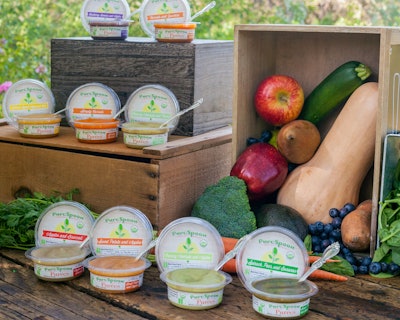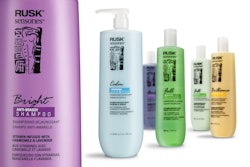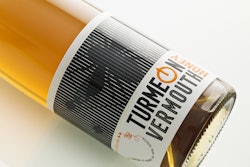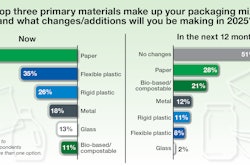In 2014, Alyson Eberle launched Pure Spoon, the first company offering 100% fresh organic baby food pasteurized through the use of High Pressure Processing. Here, Eberle shares her journey pioneering HPP technology in this new category.
Packaging World: How did Pure Spoon come about?
Alyson Eberle:
I started to spin the idea when I was a new mom. I had a four-legged child before a two-legged one, and we were buying fresh dog food for him. After my child was born, I was surprised to find there weren’t any fresh baby-food options at the grocery store.
That’s when the lightbulb went off. We moved to Austin, TX, about three years ago and sold one business to help fund this one. We dove into R&D to figure out how we could bring fresh options to parents that would be available at the grocery store. Some parents can’t make their own baby food, and some don’t want to after a while. It sounds very admirable, but it’s a lot of work.
During my research, I stumbled on an article written about High Pressure Processing. I’d never heard of it, and so I did my own research and learned that no one had ever used it for baby food or purées before. I decided that was going to be the process I would use to allow Pure Spoon to offer fresh options.
What are the advantages of HPP for fresh baby food?
When you pasteurize food with high heat, it’s nutrient-depleting, and you lose some of the flavor, texture, and pH of the food. Most importantly though, you lose a lot of vitamins and minerals. So ounce-for-ounce, you are not getting the same product you could be making at home.
HPP uses a ridiculous amount of pressure—87,000 pounds per square inch—to kill off any living organisms, any bacteria, that could spoil the food. But it doesn’t degrade the vitamins, minerals, color, flavor, or texture of the food. It allows the food to stay its true self for a long period of time.
HPP is really a beautiful way to keep food fresh. But it is more expensive and certainly more complicated, and you have to be a pioneer and roll up your sleeves and get dirty if you want open up new categories for consumers. In fact, it took 18 months to figure out this process.
Can you describe the packaging for your purées? What type of plastic is used?
We use 4.2-oz clear plastic containers made of PET. Our products are never heated; we are very conscientious about not letting any of the plastic leach into the food. We picked clear plastic rather than white or opaque because we wanted everyone to see our product. We have yellows and greens and oranges and blues—the food is just gorgeous.
The geometry of the container was also very important. Because there is so much pressure with HPP, we had to make sure the packaging was flexible enough so that there was some give and take, and that the container wouldn’t collapse on itself. No one had used HPP before for the size package we were using or for the product ingredients used in our food. It was trial and error. There were a few explosions, but we finally narrowed it down to what would work, and we got the package and lid licensed.
What is the shelf life of your product?
Sixty-five days from the time of HPP. We did what’s called a 5-log reduction study, and we were able to achieve a 90-day shelf life. But we feel the flavor profile begins to diminish at 65 to 70 days.
Where are your products sold?
We hit every state with our front-door delivery through purespoon.com. We’re also sold in Spouts Famers Market, Whole Foods Market, and Hy-Vee, and we will soon be in Kroger and Walmart.
A while back Target reached out to us, and I thought the first e-mail was spam. They wanted to offer parents better choices, so they have begun a test market in 70 stores where they have in-line refrigerators in the baby section. They are not just offering our products, but also other fresh options such as juices and yogurts. It’s doing really, really well. The response has been wonderful.
What has been the response from consumers to your product?
I think they are happy and relieved that somebody else is doing the work for them to prepare fresh foods for their babies. A lot of parents are scared about what to give their little ones, so they appreciate the research we have done to make sure we are offering items that are beneficial for their children. We worked with a licensed pediatric dietician and a food scientist to make sure all the fruit and vegetables we’re using in our products are nutrient dense.
We put in a lot of effort to educate the consumer about how we’re different from the other baby-food offerings out there and about HPP, because that’s a little confusing to people. But thanks to the premium juice companies that are using HPP, consumers are beginning to understand what it means—that it is FDA-approved and a very safe, tried-and-true pasteurization process.



























